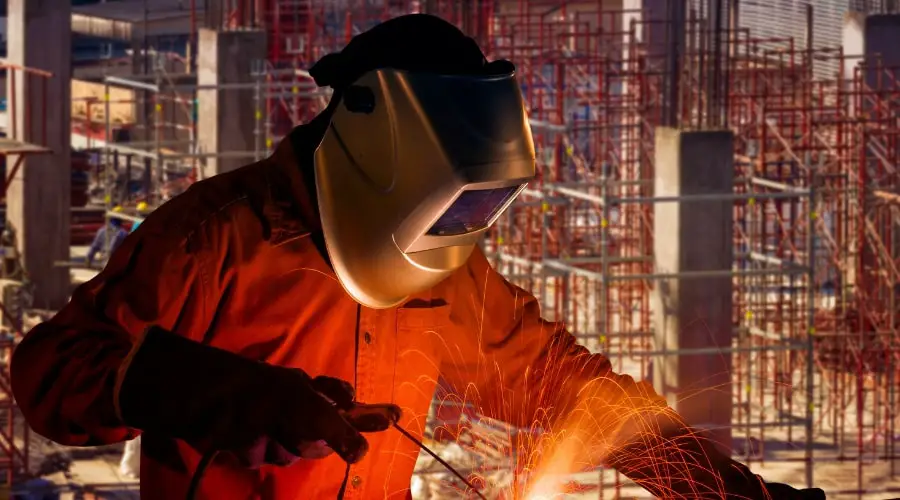Welding, an essential process in numerous industries, involves high heat and bright light that could harm the human eye. This is where the crucial role of welding helmets comes in. The dark shade of these helmets often prompts a question: why are they so dark?
This article aims to demystify the science behind the dark shade of welding helmets, their purpose, and why they are an indispensable safety tool for welders. It’s not just about fashion or making a statement; there’s much more to it. From protecting the eyes to increasing efficiency, the darkness of the helmet plays a pivotal role. Intrigued? Let’s dive in to understand more.

The Basics of Welding
Welding is a fascinating world. It’s a process where two or more parts are fused together by using high heat to form a joint. This heat is usually produced by an electric arc, reaching temperatures up to a scorching 6,500 degrees Fahrenheit!
The Process of Welding
So, what happens when this heat meets metal? The metal pieces melt, and a filler material is often used to form a pool of molten material (the weld pool) that cools to become a strong joint. But this isn’t just a hot job; it’s also dangerous. And that’s where welding helmets come into the picture.
Understanding Welding Helmets
The Purpose of Welding Helmets
Ever wondered why welders always seem to be hiding behind those large, dark helmets? They’re not just for looking fabulous – these helmets serve a crucial purpose. They protect the welder’s eyes and face from harmful infrared and ultraviolet rays produced during welding.
Types of Welding Helmets
Welding helmets come in various types and shades, from the traditional passive helmets to the more advanced auto-darkening ones. But they all have one thing in common: they’re dark. And there’s a good reason for that.
The Science Behind Dark Welding Helmets
Importance of Dark Shades in Welding Helmets
The darkness of welding helmets plays a pivotal role in protecting a welder’s eyesight. Welding produces bright light that can cause a condition called ‘arc eye’ or ‘welder’s flash’, like getting sunburned in the eye! Ouch! The welding helmet’s dark shade helps prevent this condition by reducing the intensity of light and harmful radiation reaching the eyes.
How Welding Helmets Protect the Eyes
The dark shade of the helmet absorbs the high-intensity light from the welding process, allowing only a safe amount of light to pass through. This way, the welder can still see what they’re doing without risking their eyesight.
The Role of Auto-Darkening Welding Helmets
The Technology Behind Auto-Darkening Helmets
Auto-darkening helmets are a game-changer in the world of welding. They have a feature that automatically adjusts the lens’s darkness based on the arc’s brightness. These helmets use light sensors to detect the start of the welding process and darken the lens in a fraction of a second. Quite neat, right?
The Benefits of Using Auto-Darkening Helmets
Using an auto-darkening helmet has multiple benefits. It allows the welder to work more efficiently as they don’t have to lift the helmet to inspect their work manually. The automatic adjustment ensures optimal eye protection at all times, reducing the risk of eye injury.
Choosing the Right Shade for Your Welding Helmet
Factors to Consider
When choosing a welding helmet, you should consider the type of welding you’re doing and the amperage you’re using. As a rule of thumb, the higher the amperage, the darker the helmet should be. Most helmets have a shade range between #9 and #13, with #13 being the darkest.

Tips for Using Welding Helmets
Remember, a welding helmet is just one part of staying safe while welding. You should also wear appropriate clothing, use the right welding techniques, and ensure a safe working environment. After all, safety should be your number one priority.
Frequently Asked Questions:
Why can’t I use sunglasses instead of a welding helmet?
Sunglasses don’t provide the same level of protection as welding helmets. They’re not designed to withstand the intensity of light produced during welding, and they don’t cover your entire face.
How do I know if my welding helmet is dark enough?
The helmet should be dark enough that you can comfortably look at the arc without squinting or experiencing discomfort. If unsure, it’s best to start with a darker setting and adjust as necessary.
Can I get a sunburn from welding?
Yes, you can! Welding produces intense ultraviolet light that can burn your skin and eyes like the sun. That’s why wearing protective gear, including a welding helmet, is essential.
How often should I replace my welding helmet?
The lifespan of a welding helmet depends on how often it’s used and how well it’s taken care of. Generally, replacing your helmet every five years or so is a good idea.
Can I weld without a helmet?
No, it would be best if you never welded without a helmet. The risks to your eyes and face are too significant. Always prioritize your safety when welding.
Conclusion
So, why are welding helmets so dark? The simple answer is to protect your eyes from the harmful light and radiation produced during welding. Whether you’re using a traditional passive helmet or an auto-darkening one, the darkness of the helmet is crucial in maintaining your eye health and ensuring a successful welding project. Safety first, right?
Helmetslab is a website that focuses on providing in-depth reviews and information about different types of helmets, including motorcycle helmets and others helmets. I am writing a post with proper research on the info that helps helmet users.

